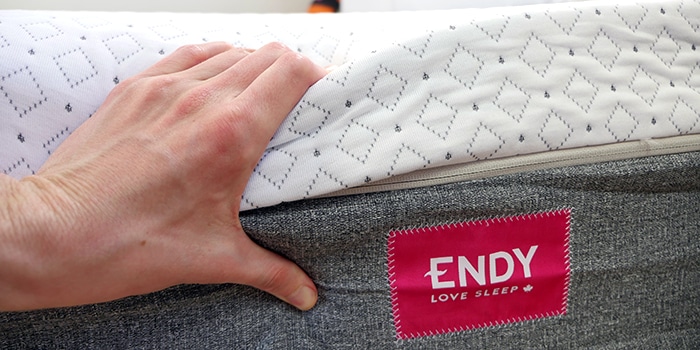
Best For
- Extremely fast response time
- Excellent edge support, only 3.25″ of sinkage when seated at the edge
- Sleepers on a budget, looking for a mattress under $900
Considerations
- May not be supportive enough for sleepers over 250 lbs.
- Extremely high level of bounce at 12.45″ of total bounce
Our Verdict
The Endy is a 10″ foam mattress that uses poly foam for comfort and support. This mattress is budget-friendly, ships quickly, and provides a slightly firm feel. Its firmness is a 7 out of 10, where 10 is the most firm.
It has very minimal sinkage and very high bounce, which gives it a lively feel that avoids any sort of “stuck” sensation.
Due to the thinner profile and slightly firm feel, I would not recommend this mattress to lightweight side sleepers and would advise sleepers over 250 lbs. to use caution before selecting this mattress.
For more moderate weighted bodies, especially back and stomach sleepers, the 10″ profile and slightly firm feel is ideal.
The Endy performance score of 9.09 ranks it among the top 15% of all mattresses and its the 7th best foam mattress we’ve tested to date. Its price is 39% lower than the average foam model, which is a savings of C$562.
Absolutely, it has its weak spots and it’s far from perfect, but if those issues aren’t deal breakers for you it be a great value pick. Notably, the Endy is not available for purchase in the U.S. at this time.
Type: Foam
Firmness: Slightly Firm (7)
Best For: All Sleeping Positions, Moderate Weighted Sleepers (150-250 lbs.)
In This Review
Performance Tests | Firmness | Support & Sleeping Positions | Design | Materials | Comparisons | FAQs
Performance Tests
At NapLab, we put each mattress to the test.
We test 10 different factors that impact the performance, comfort, and value of the mattress. We then take the results of that test and compare to every mattress we’ve tested to date.
Check out the full performance table below to see how this mattress ranks:
| Factor | Endy | Average |
|---|---|---|
| Overall Score | 9.09 | 8.55 |
| Price (Queen) | C$895 | C$1,457 (Foam only) |
| Cooling – Score | 9.0 | 8.7 |
| Sinkage – Depth | 1.47″ | 2.15″ |
| Sinkage – Feel | Very Minimal | Moderate |
| Motion Transfer – Score | 9.3 | 8.2 |
| Motion Transfer – Acceleration | 6.62 m/s² | 8.79 m/s² |
| Response Time – Score | 10 | 8.9 |
| Response Time – Mostly Recovered | 0.2 sec. | 0.4 sec. |
| Response Time – Fully Recovered | 0.3 sec. | 0.9 sec. |
| Bounce – Height | 12.45″ | 9.52″ |
| Bounce – Feel | Very High | Moderate |
| Edge Support – Score | 9.4 | 8.6 |
| Edge Support – Sitting | 3.25″ | 4.05″ |
| Edge Support – Lying | Excellent | Good |
| Sex – Score | 9.8 | 8.4 |
| Pressure Relief – Score | 8.0 | 8.7 |
| Comfort Layer Thickness | 2.0″ | 4.1″ |
| Mattress Thickness | 10″ | 12.0″ |
| Off-Gassing – Score | 8.3 | 8.2 |
| Off-Gassing – Smell | Strong | Strong |
| Off-Gassing – Days | 6 days | 6 days |
| Company – Score | 9.6 | 8.8 |
| Trial | 365 nights | 178 nights |
| Warranty | 15 years | 25% have lifetime warranties, average of other 75% of mattresses is 13 years |
How is Endy Different?
The Endy all-foam mattress has a significantly higher level of performance than average, and it also a lower price tag, priced 39% lower than the average foam mattress.
Advantages
Looking closer at performance, we see that the Endy has slightly better cooling, much faster response time, and better edge support than the average mattress.
Neutral Factors
Looking strictly at preferential factors, the Endy has much less sinkage (32% less) and much more bounce (31% more) than average.
Disadvantages
It also has a thinner profile, by nearly 2″. This makes it unsuitable for heavier weighted sleepers and it also limits pressure relief performance for all sleepers. Motion transfer was fairly high and response time had some room for improvement.
Cooling Test
The cooling performance on the Endy is excellent. During our tests, I felt no significant level of heat retention around my body.
Baseline Temp.
80.2° F
Max Temp.
92.0° F
Ending Temp.
84.9° F
The two greatest factors contributing to the cooling performance are the floating feel (due to the slightly firm feel) and the limited comfort layer. The slightly firmer feel of the mattress causes sleepers to sleep more on “top of the mattress” as opposed to “in” the mattress.
Max Temp.

Ending Temp

- Baseline Temperature – the temperature of the mattress before anyone lies on it
- Maximum Temperature (0 minute) – the temperature of the mattress after lying on it for 15 minutes
- Ending Temperature (5 minute) – the temperature of the mattress after being lied upon and having no one on it for 5 minutes
By not having the mattress wrap and contour around the body as dramatically there is a reduced level of heat retention capacity.
In addition, while the mattress does use an all-foam design, which is a negative for cooling, the thinner 2.0” comfort layer on top helps by being physically thinner, and therefore less able to absorb more heat.
Thicker comfort layers, while beneficial for pressure relief, can cause mattresses to absorb and retain more heat.
Heat Dissipation Over Time
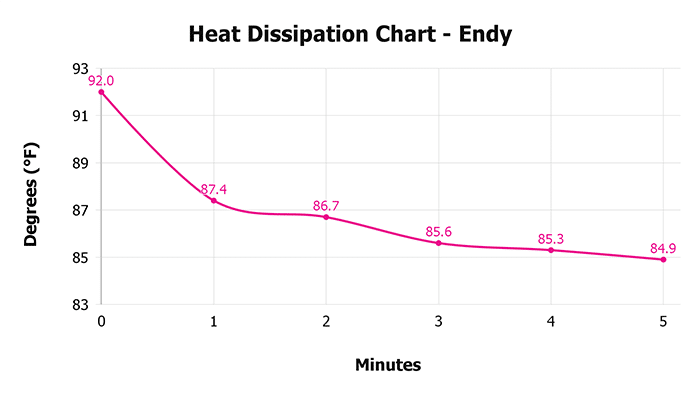
Sinkage Test
The Endy mattress has a very minimal level of sinkage. In our tests, we measured just 1.47” of pressure point sinkage depth. This is 0.68” less sinkage than the average of 2.15”.
Sinkage Depth
1.47″
Sinkage Feel
Very Minimal
Body Contour
Slight
The level of sinkage is documented in the image below.
As we discussed in the cooling section, the Endy creates more of a “floating on top” of the mattress feel. The slightly firm feel of the mattress creates very little sinkage or body contouring.

While heavier portions of the body (ie, butt and midsection) do sink deeper, the totality of the feel is one of minimal body contouring, minimal sinkage, and floating more on top of the foams.
Sleepers who like foams that wrap and hug the body will not be well served by the Endy. While sleepers who want less foam hugging the body will likely love the feel.
Motion Transfer Test
The Endy has a very low level of motion transfer. In our motion transfer tests, we measured a total acceleration range of 6.62 m/s². This is 25% less motion than the average of 8.79 m/s².
Accel. Range
6.62 m/s²
Motion Duration
1.06 seconds
Despite the slightly firm feel, the Endy managed to keep motion quite restrained. Typically, mattresses with a firmer feel (even all foam mattresses) can struggle with motion, as the firmer feel rebounds more energy.
The level of motion transfer is also documented in the video below.
In our motion transfer chart, which visualizes our accelerometer data, we see the highest motion spikes from 0 to 0.22 seconds. Motion drops after 0.22 seconds, but we do see continued energy transfer until 1.06 seconds, when it returns to near zero levels
Motion Transfer Over Time
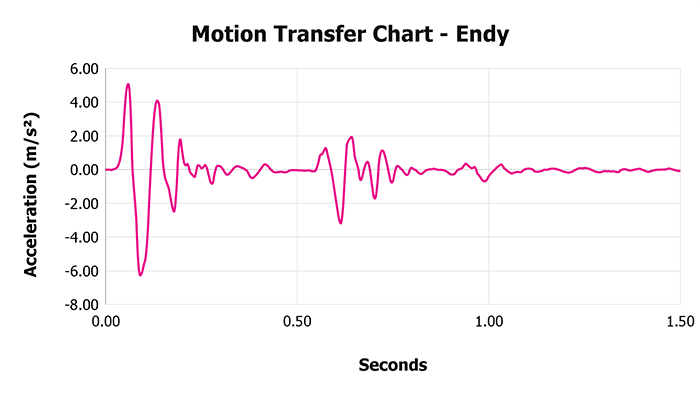
While I am pleased that the initial motion spike was kept in check, the total motion duration is quite longer than is ideal. Mattresses with the least motion transfer are able to disperse all energy within 0.3 seconds. Needless to say, it takes the Endy quite a bit longer to completely eliminate all motion.
Testing Update – we have conducted two motion transfer tests for the Endy. The first test showed a very high level of motion transfer. Endy was surprised by the results and thought a bad batch of foam may be to blame. They sent us a 2nd mattress for re-testing, which we found had considerably less motion transfer. Our analysis and scores are based on the re-test data.
Response Test
The Endy has an extremely fast response time. In our tests, we measured a mostly recovered material response of 0.2 seconds and a fully recovered material response of 0.3 seconds.
Mostly Recovered
0.2 sec.
Complete Recovery
0.3 sec.
This is effectively instant recovery speed and is tied for the fastest recovery speed we’ve tested to date. The all-poly foam design (as opposed to memory foam) and slightly firm feel both work together to create rapid response.
The level of responsiveness is documented in the video below.
Most poly foams rebound back to shape quickly, and the limited sinkage due to the slightly firm feel ensures that sleepers don’t excessively compress foams. Overall, I don’t expect responsiveness will be an issue for most sleepers.
Bounce Test
The Endy has an extremely high level of bounce. In our tests, we measured 12.45” of total bounce height. This is 2.93” more bounce than the average of 9.52” (based on all of our tests to date).
Max. Depth
5.32″
Max. Rebound
7.13″
Total Bounce
12.45″
The slightly firm feel and all poly foam design is driving much of the performance here. The firmer feel creates more pushback, which rebounds energy back more sharply, creating higher bounce.
Max. Sinkage Depth

Max Bounce Height

The level of bounce is also documented in the video below.
Ideally, I like to see 8-12” of total bounce height. As a result, the Endy is a bit north of the sweet spot, but only slightly.
While the higher bounce is creating higher motion transfer, it’s also greatly contributing to improved sex performance and ease of movement. So there are pros and cons here.
Edge Support Test
The Endy has excellent sitting and lying edge support. In our sitting edge support tests, we measured a sitting sinkage compression of 3.25”. This is 0.80” less sitting compression than the average of 4.05”.
Ideally, I like to see 4.0” or less, so the Endy easily hit that mark. Even when sitting directly on the edge of the mattress I felt well supported.
Max. Sinkage
3.25″
Lying Support
Excellent
Reinforced Edge
No
The level of edge support while seated is documented in the images below.
Sitting, 140 lbs.

Sitting, 200 lbs.

Lying edge support was equally as good. I felt well-supported in all sleeping positions when lying directly on the edge of the mattress.
The level of edge support while lying is documented in the images below.
Lying on Edge, 140 lbs.

Lying on Edge, 200 lbs.

While the design of the mattress limits pressure relief performance (which we discuss two sections down), it greatly benefits edge support.
The slightly firm feel and 8.0” of transitional and support poly foam create ample support in general and for edges.
Sex Test
The Endy has an outstanding sex score.
The best mattresses for sex have high bounce, good edge support, quiet materials, and good pressure relief and cooling. And that’s what we see here.
| Sex Factor | Factor Weight | Score | Rating |
|---|---|---|---|
| Bounce | 65% | 10 | Extremely High |
| Edge Support | 20% | 9.7 | Excellent |
| Noise | 5% | 10 | Minimal |
| Pressure Relief | 5% | 8.0 | Good |
| Cooling | 5% | 9.0 | Excellent |
This mattress has very high levels of bounce and excellent edge support. These two factors alone make up 80% of the sex score.
It has a slightly firm feel, which provides a bit of pushback for intimacy. The firmer feel does lose some points for pressure relief, but overall this mattress is great for sex.
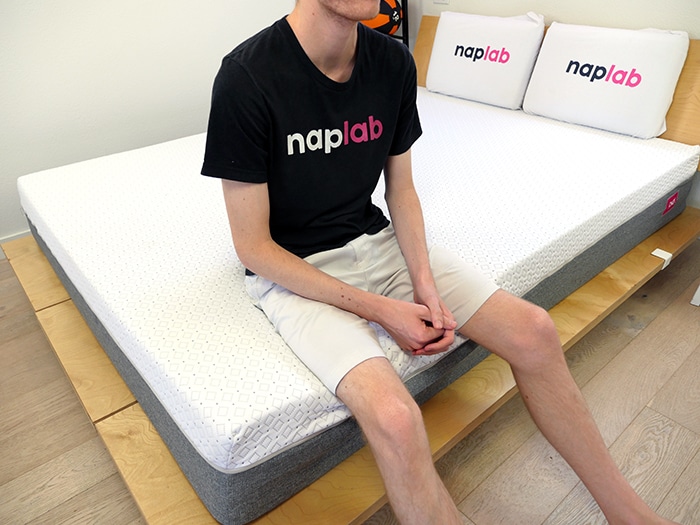
Pressure Relief Test
Pressure relief on the Endy is good, but doesn’t quite reach the great level that I would hope for.
In our tests, at times I felt a slight level of building pressure (mostly isolated to my upper back). When we look at the material design it’s a bit of a mixed bag. We really only have 2.0” of comfort material. The 3.0” core layer is more of a transitional poly foam.
Comfort Layer
2.0″
Support Layer
8.0″
While it provides some level of pressure relief, its primary objective (in my view) is one of transition into the support foam layer. As such, I don’t think it’s going to create a significant level of additional pressure relief for sleepers, at least relative to what the top 2.0” comfort layer creates.
All that to say, I think heavier-weighted sleepers are most likely to experience a lack of pressure relief. While lighter and moderate-weighted bodies are more likely to find pressure relief fine. The biggest potential pressure relief issue is simply the level of firmness.
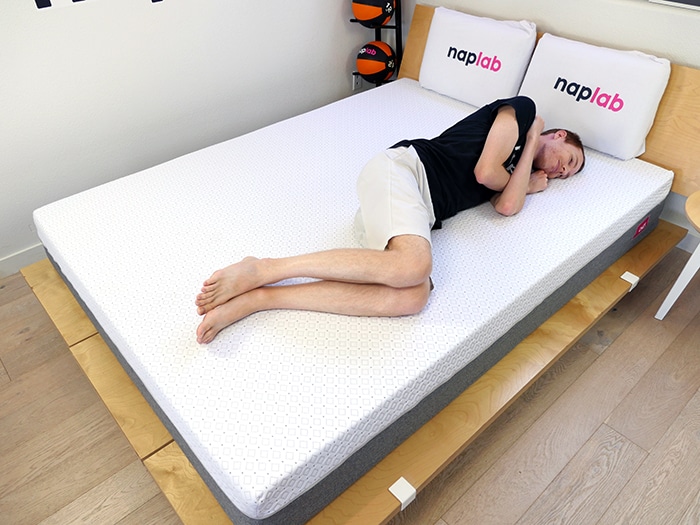
This mattress has a slightly firm feel. For back and stomach sleepers that’s often ideal. However, many side sleepers need more of a medium soft, medium, or medium-firm feel.
The slightly firm feel may simply be too much for many side sleepers, pushing the mid-section out of proper alignment, thereby creating pressure point issues.
Off-Gassing Test
Off-gassing on the Endy was good, but nothing special.
The smell was strong right out of the box and odors lasted for 6 days. During the first several days the smell was strong and smelled a bit like wet paint.
Initial Smell Strength
Strong
Off-Gassing Period
6 days
After day 6 the smell had fully dissipated and there was no longer any strong odor. The average off-gassing period based on all of our tests to date is 6.4 days.
Testing Update – we have tested the Endy’s off-gassing twice. The first test was notably worse at 23 days. Endy was surprised at the performance and believe a bad batch of foam was to blame. They sent us a 2nd Endy mattress to re-test, which we found to be considerably better, only smelling for 6 days. Our scores are based on the re-test data.
Company
The company score takes a look at factors that may influence your experience with the mattress.
Factors include length of the trial period, warranty, shipping / return costs, and country of origin.
| Company Factor | Factor Weight | Score | Data |
|---|---|---|---|
| Returns | 40% | 10 | $0 |
| Trial Period | 30% | 10 | 365 nights |
| Warranty | 20% | 8.0 | 15 years |
| Shipping | 10% | 10 | $0 |
| Country of Origin | 0% | Canada |
Endy offers a 365-night trial period and a 15-year warranty. Shipping is free (to all Canadian provinces) straight to your door and if the mattress ends up not working out, you can return it for free.
For an additional cost Endy will also ship to the following locations.
- Whitehorse, Yukon
- Yellowknife, Northwest Territories
- Iqaluit, Nunavut
Endy mattresses are made in Canada.
How firm is the Endy?
The Endy mattress has a slightly firm feel with a firmness rating of 7 out of 10, where 10 is the most firm.

This is firmer than many other medium-firm mattresses and may not be suitable for all sleepers. The slightly firm feel is best suited to back and stomach sleepers. In addition, some heavier weighted side sleepers may also find the slightly firmer feel appealing.
Support & Sleeping Positions
Support on the Endy is excellent. During our tests, I felt well-supported in all sleeping positions. While the general support is indeed excellent, the slightly firm feel isn’t for everyone.
| Support Factor | Data |
|---|---|
| Comfort Layer | 2.0″ |
| Support Layer | 8.0″ |
| Firmness | Slightly Firm |
| Body Contour | Slight |
| Zoned Support | No |
| Reinforced Edge | No |
Stomach and back sleepers are likely to find support to be better, while side sleepers are likely to find support isn’t quite right (pushes midsection out of alignment, potential pressure point build-up).
Lighter-weight side sleepers in particular should exercise the greatest caution.
The thinner 10” profile is better suited to lighter and moderate-weighted bodies (especially back and stomach sleepers).
In addition, I also wouldn’t go above 250 pounds on this mattress (or most 10” mattresses in general).
| Sleeper Weight | Stomach Sleepers | Side Sleepers | Back Sleepers |
|---|---|---|---|
| Under 150 lbs. | Yes | No | Yes |
| 150-250 lbs. | Yes | Yes | Yes |
| 250-300 lbs. | Maybe | Maybe | Maybe |
All that to say, given the price point, the level of performance is still quite good. I hate to complain too much about support, as it’s everything I expect at this price point.
Design
The Endy all-foam is a 10″ mattress with a balanced feel. It is designed to be slightly firm (7 out of 10) and is a budget-friendly all-foam mattress aimed at appealing to a wide range of sleeper preferences.
| Design Factor | Data |
|---|---|
| Type | Foam |
| Thickness | 10″ |
| Cover Type | Thin |
| Weight | 59 lbs. |
| Has Handles | No |
| Fiberglass-Free | Yes |
| Ships in a Box | Yes |
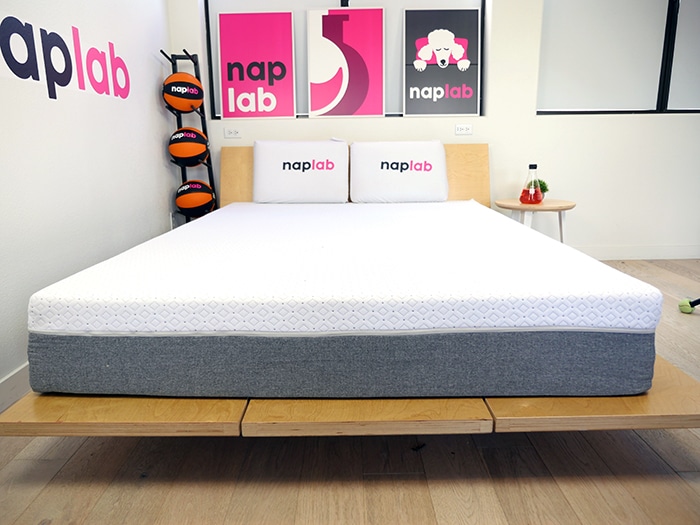
Materials
In total, there are three layers on the Endy mattress. From top to bottom, these layers include:
| Layer Type | Thickness | Layer Specs |
|---|---|---|
| Poly Foam | 2.0″ | Not Available |
| Poly Foam | 3.0″ | Not Available |
| Support Foam | 5.0″ | Not Available |
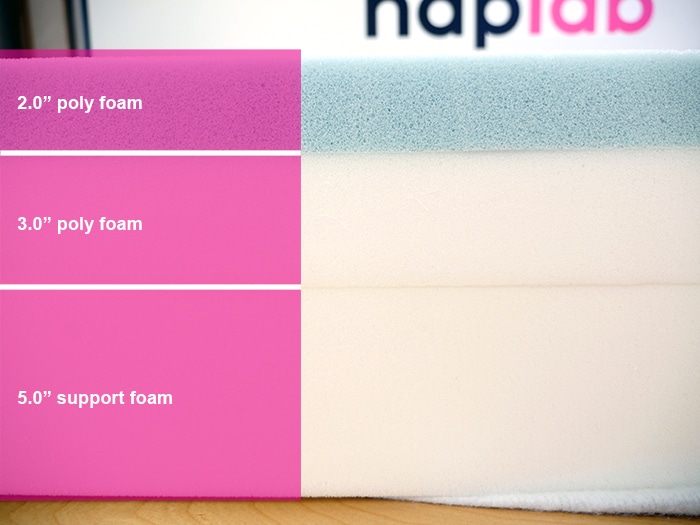
The Cover
The cover of the Endy mattress is soft and with four-way stretch. The fabric is micro-quilted with dark gray accents.

The cover also zips off and is machine-washable. If you’re worried about keeping the surface of your mattress clean, this is a nice feature to have in a mattress.
The Comfort Layer
The comfort layer is made up of two foam layers. The top is a 2″ thick open-cell poly foam and the secondary layer is a 3″ poly foam.
The second layer is more of a transitional poly foam. I am not sure I’d qualify this as pure comfort foam…but it’s also not a support material.
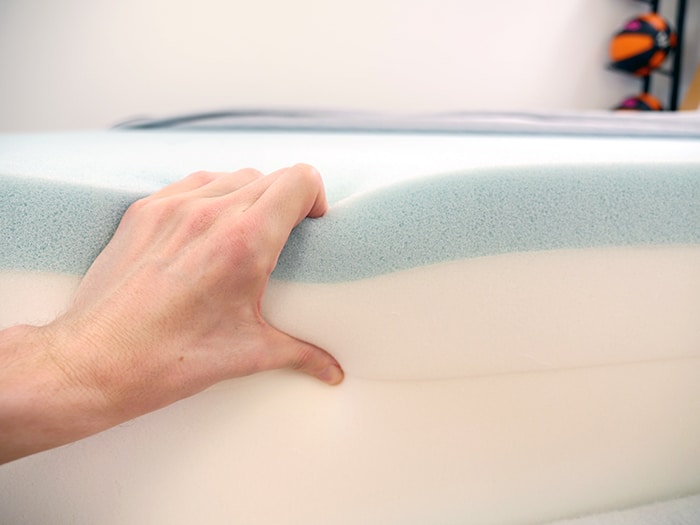
The transitional foam has a higher density than the comfort foam and is designed to transfer pressure from the top layer into the support layer.
The Support Layer
Since the transitional layer is a bit thicker on the Endy, the pure support layer is on the thinner side, only 5″ thick.

This support foam at the base has the highest density of all foams used in the Endy mattress.
Product Evolution
The Endy mattress was first released in 2015. The original version of the Endy mattress was a 10″, 3 layer mattress with layers as follows:
- 2.0″ gel memory foam
- 3.0″ transitional poly foam
- 5.0″ support foam
This is substantially identical to the mattress that Endy is still selling as of 2023. As a result, there have been no major changes to the product design since it’s inception in 2015.
Other Mattresses to Consider
Not sure if the Endy is the right mattress for you? Check out these three other alternative you may want to consider.
For Medium Feel

Douglas
All-Foam Design
The Douglas is a 3 layer 10″ all foam mattress. This mattress has a slightly softer feel than the Endy (6 out of 10). Douglas is also a Canadian-based mattress company.
*Available in the US here
For Hybrid
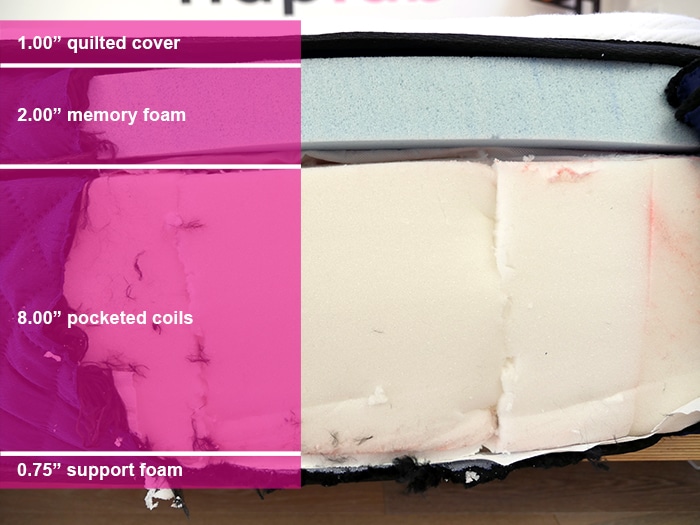
Silk & Snow Hybrid
Budget-Friendly
The Silk & Snow is a 12″ hybrid mattress built from 4 layers. It has a medium-firm feel and performed well in our battery of tests. It’s also a great value at $800 for a queen mattress, 46% less than the average hybrid.
For Memory Foam
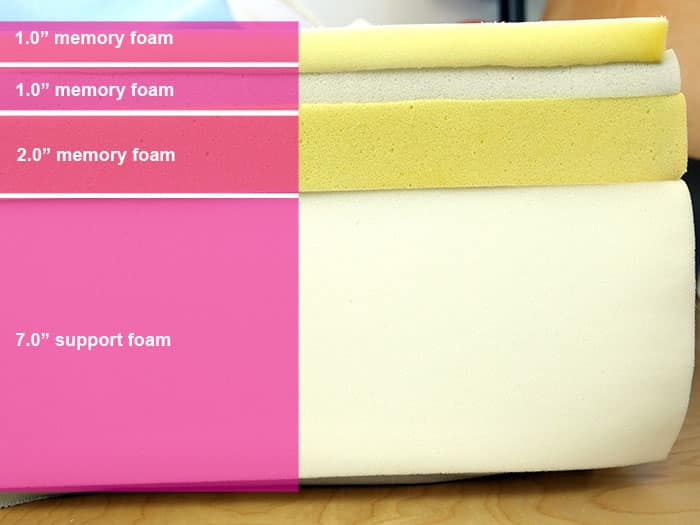
Novosbed
4″ Memory Foam Layer
Novosobed is a 10″ memory foam mattress available in 3 different firmnesses. It has a more classic memory foam feel with a high degree of contour and hug. It’s a little more expensive, but it also performed better in our tests.
Frequently Asked Questions
Still have questions? Check out some of the top FAQs on the Endy mattress below and get the answers you’re looking for.
Here are the current prices, with any sales or promotions reflected below:
Twin: $675
Twin XL: $745
Full: $820
Queen: $895
King: $995
Cal. King: $1,045
*Note: Sales prices are subject to change without notice or warning.



